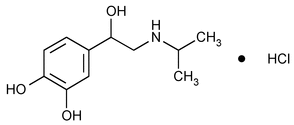Isoproterenol Hydrochloride
(eye'' soe proe ter' e nol hye'' droe klor' ide).
1,2-Benzenediol, 4-[1-hydroxy-2-[(1-methylethyl)amino]ethyl]-, hydrochloride.
3,4-Dihydroxy-
» Isoproterenol Hydrochloride contains not less than 97.0 percent and not more than 101.5 percent of C11H17NO3·HCl, calculated on the dried basis.
Packaging and storage—
Preserve in tight, light-resistant containers.
Identification—
Melting range  741
741 :
between 165
:
between 165 and 170
and 170 .
.
Loss on drying  731
731 —
Dry about 1 g, accurately weighed, in vacuum over phosphorus pentoxide for 4 hours: it loses not more than 1.0% of its weight.
—
Dry about 1 g, accurately weighed, in vacuum over phosphorus pentoxide for 4 hours: it loses not more than 1.0% of its weight.
Residue on ignition  281
281 :
not more than 0.2%.
:
not more than 0.2%.
Sulfate  221
221 —
A 0.10-g portion shows no more sulfate than corresponds to 0.20 mL of 0.020 N sulfuric acid (0.2%).
—
A 0.10-g portion shows no more sulfate than corresponds to 0.20 mL of 0.020 N sulfuric acid (0.2%).
Limit of isoproterenone—
Its absorptivity (see Spectrophotometry and Light-scattering  851
851 ) at 310 nm, determined in a solution containing 2 mg per mL, is not more than 0.2.
) at 310 nm, determined in a solution containing 2 mg per mL, is not more than 0.2.
Chloride content—
Dissolve about 500 mg, accurately weighed, in 5 mL of water. Add 5 mL of glacial acetic acid and 40 mL of methanol. Add eosin Y TS, and titrate with 0.1 N silver nitrate VS. Each mL of 0.1 N silver nitrate is equivalent to 3.545 mg of Cl. Between 13.9% and 14.6% of Cl is found, calculated on the dried basis.
Assay—
Standard preparation—
Dissolve an accurately weighed quantity of USP Isoproterenol Hydrochloride RS in freshly prepared sodium bisulfite solution (3 in 1000) to obtain a solution having a concentration of about 2.5 mg per mL. Transfer 5.0 mL of this solution to a 50-mL volumetric flask, dilute with 0.17 N acetic acid to volume, and mix to obtain a solution having a known concentration of about 250 µg per mL.
Assay preparation—
Transfer about 125 mg of Isoproterenol Hydrochloride, accurately weighed, to a 25-mL volumetric flask, dissolve in sodium bisulfite solution (3 in 1000), dilute with sodium bisulfite solution to volume, and mix. Transfer 5.0 mL of this solution to a 100-mL volumetric flask, dilute with 0.17 N acetic acid to volume, and mix.
Chromatographic system
(see Chromatography  621
621 )—The liquid chromatograph is equipped with a 278-nm detector and a 30-cm × 4-mm stainless steel column that contains packing L1. The mobile phase is 0.17 N acetic acid having a flow rate of about 1.5 mL per minute. Chromatograph five replicate injections of the Standard preparation, and record the peak responses as directed for Procedure: the relative standard deviation is not more than 3.0%.
)—The liquid chromatograph is equipped with a 278-nm detector and a 30-cm × 4-mm stainless steel column that contains packing L1. The mobile phase is 0.17 N acetic acid having a flow rate of about 1.5 mL per minute. Chromatograph five replicate injections of the Standard preparation, and record the peak responses as directed for Procedure: the relative standard deviation is not more than 3.0%.
Procedure—
Using a microsyringe or sampling valve, chromatograph 10 µL of the Standard preparation, and adjust the specimen size and other operating parameters, if necessary, until satisfactory chromatography and peak responses are obtained. Chromatograph equal volumes of the Standard preparation and the Assay preparation, and measure the peak responses. Calculate the quantity, in mg, of C11H17NO3·HCl in the portion of Isoproterenol Hydrochloride taken by the formula:
0.5C(hU / hS)
in which C is the concentration, in µg per mL, of USP Isoproterenol Hydrochloride RS in the Standard preparation; and hU and hS are the peak responses obtained from the Assay preparation and the Standard preparation, respectively.
Auxiliary Information—
Please check for your question in the FAQs before contacting USP.
| Topic/Question | Contact | Expert Committee |
|---|---|---|
| Monograph | Mary S. Waddell
Scientific Liaison 1-301-816-8124 |
(SM42010) Monographs - Small Molecules 4 |
| Reference Standards | RS Technical Services 1-301-816-8129 rstech@usp.org |
USP35–NF30 Page 3578
Pharmacopeial Forum: Volume No. 29(5) Page 1509

